Abstract
1 A range of histamine analogues have been examined as potentiators of the adenosine-stimulated accumulation of cyclic adenosine 3',5'-monophosphate (cyclic AMP) in slices of guinea-pig cerebral cortex. Dose-response curves were constructed for the 6 most active compounds and characterized in terms of the IC50, the slope and the maximum response attainable relative to that of histamine. 2 Histamine, 2-thiazolylethylamine and N alpha-methylhistamine produced a maximal or near maximal response. N alpha, N alpha-dimethylhistamine and 2-methylhistamine appear to be partial agonists. 3 The response to all the agonists was practically abolished by mepyramine 1 microM, indicating that the response is mediated largely or wholly via histamine H1-receptors. 4 The relative potencies of the agonists on cyclic AMP accumulation were in general similar to relative potencies in causing contraction of intestinal smooth muscle. The biggest difference was observed with N alpha-methylhistamine. 5 The histamine analogues were also examined as inhibitors of [3H]-mepyramine binding in homogenates of guinea-pig cerebral cortex. The inhibition curves were characterized in terms of IC50, the slope and the maximum percentage inhibition. This last value was compared with the inhibition produced by promethazine 2 microM. 6 For the 6 most potent agonists, the EC50 for cyclic AMP accumulation was compared with the IC50 against [3H]-mepyramine binding, corrected for inhibition of non-receptor binding and for competition with [3H]-mepyramine. With the possible exception of 2-pyridylethylamine, the values did not differ by more than a factor of 3.
Full text
PDF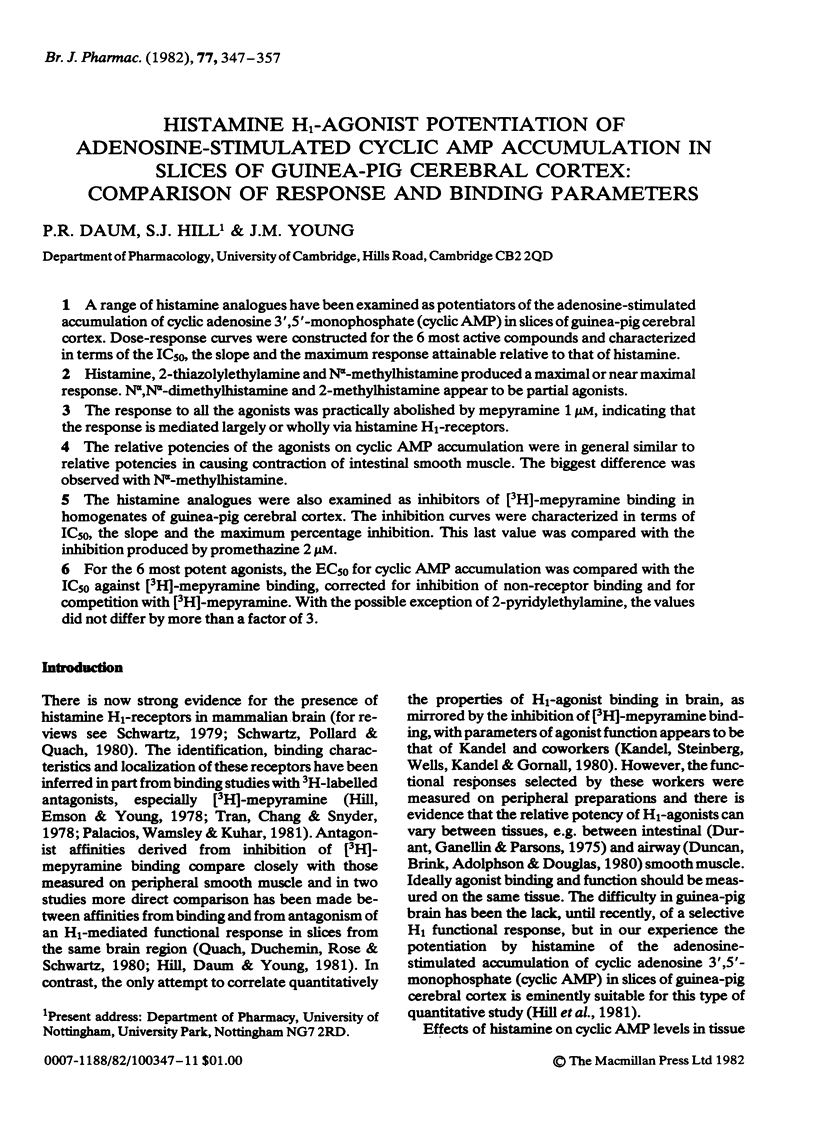



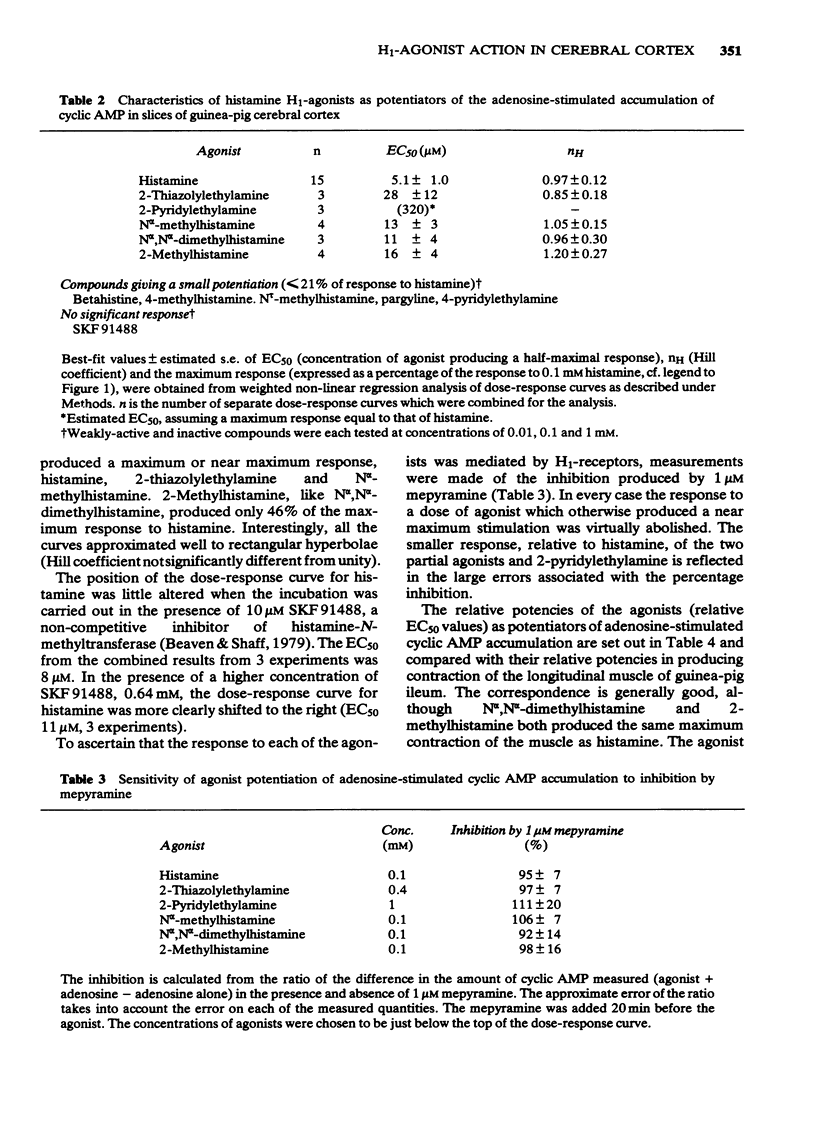
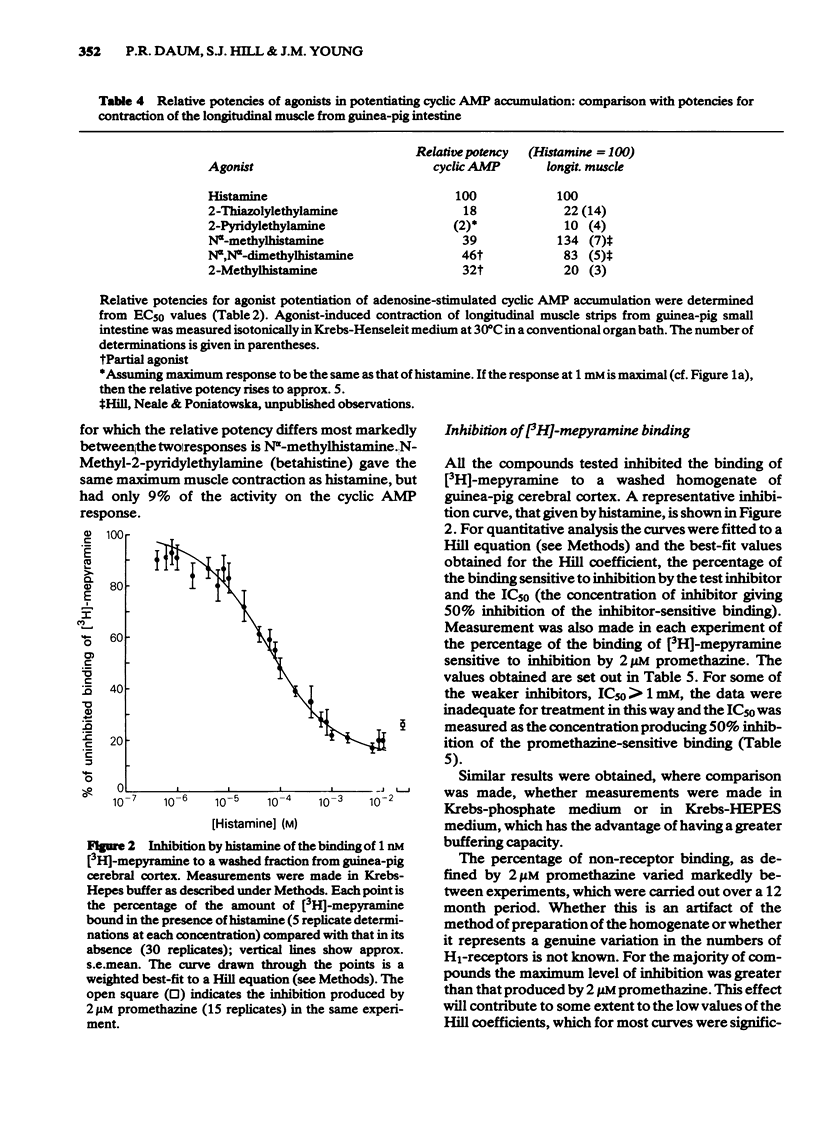

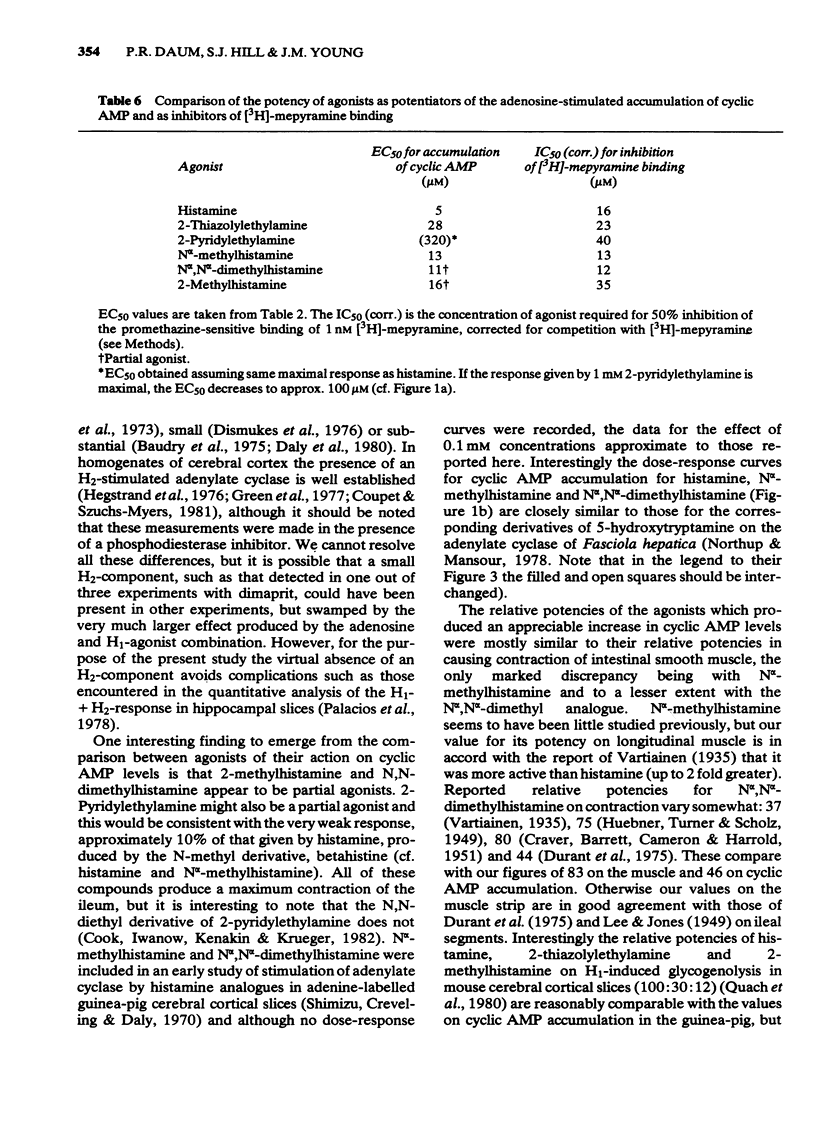

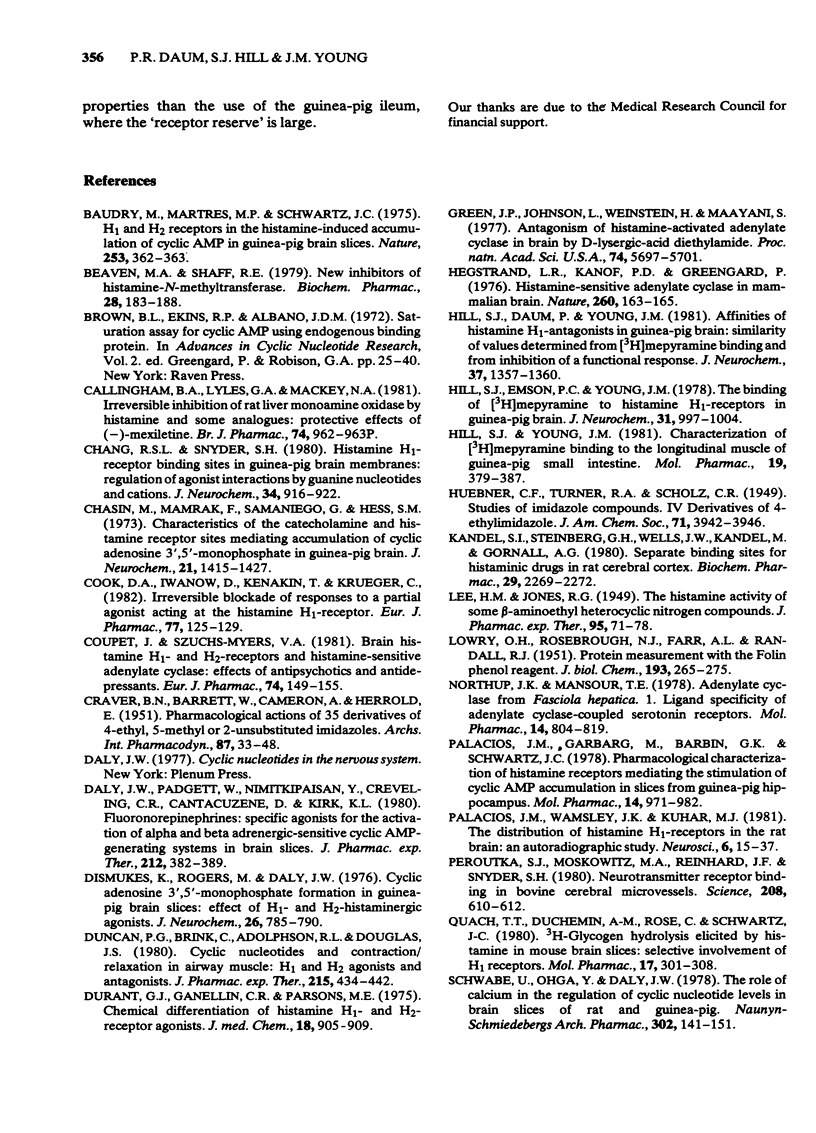
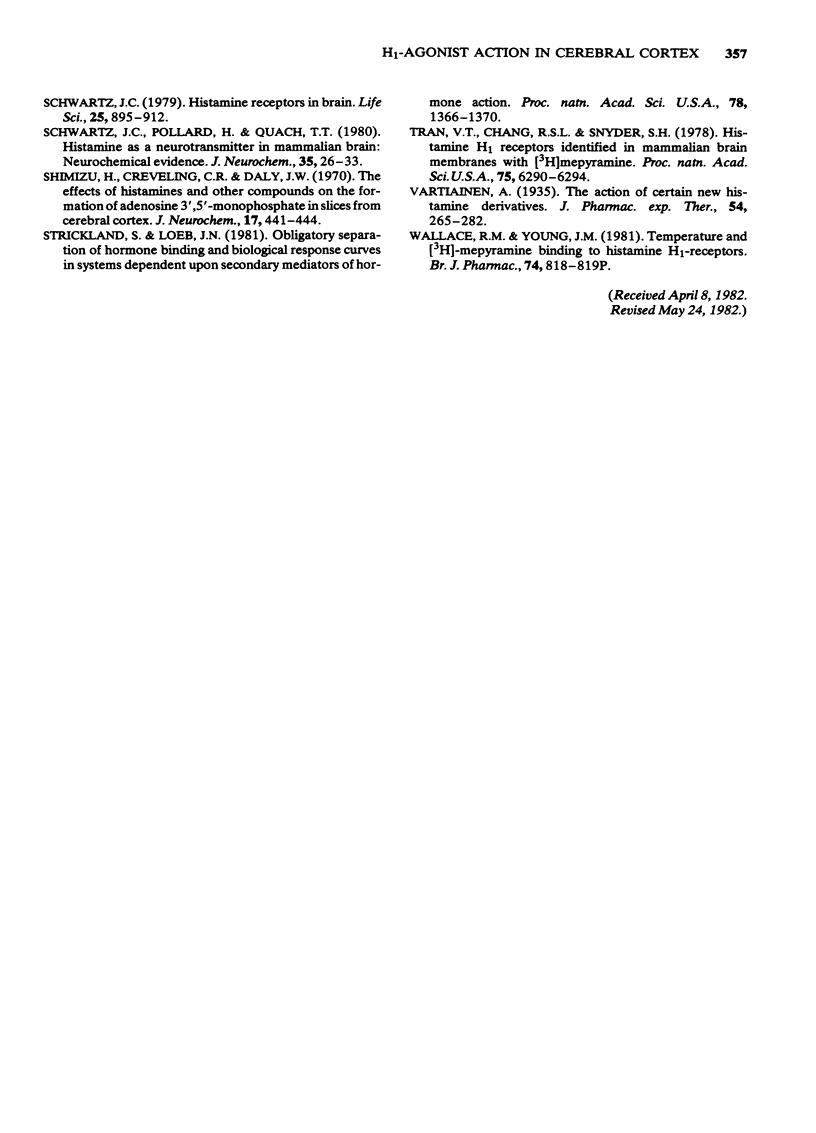
Selected References
These references are in PubMed. This may not be the complete list of references from this article.
- Baudry M., Martres M. P., Schwartz J. C. H1 and H2 receptors in the histamine-induced accumulation of cyclic AMP in guinea pig brain slices. Nature. 1975 Jan 31;253(5490):362–364. doi: 10.1038/253362a0. [DOI] [PubMed] [Google Scholar]
- Beaven M. A., Shaff R. E. New inhibitors of histamine-N-methyltransferase. Biochem Pharmacol. 1979;28(2):183–188. doi: 10.1016/0006-2952(79)90500-8. [DOI] [PubMed] [Google Scholar]
- Brown B. L., Ekins R. P., Albano J. D. Saturation assay for cyclic AMP using endogenous binding protein. Adv Cyclic Nucleotide Res. 1972;2:25–40. [PubMed] [Google Scholar]
- CRAVER B. N., BARRETT W., CAMERON A., HERROLD E. Pharmacological actions of 35 derivatives of 4-methyl, 5-ethyl or 2-substituted imidazoles. Arch Int Pharmacodyn Ther. 1951 Jul;87(1-2):33–48. [PubMed] [Google Scholar]
- Chang R. S., Synder S. H. Histamine H1-receptor binding sites in guinea pig brain membranes: regulation of agonist interactions by guanine nucleotides and cations. J Neurochem. 1980 Apr;34(4):916–922. doi: 10.1111/j.1471-4159.1980.tb09666.x. [DOI] [PubMed] [Google Scholar]
- Chasin M., Mamrak F., Samaniego G., Hess S. M. Characteristics of the catecholamine and histamine receptor sites mediating accumulation of cyclic adenosine 3',5'-monophosphate in guinea pig brain. J Neurochem. 1973 Dec;21(6):1415–1427. doi: 10.1111/j.1471-4159.1973.tb06026.x. [DOI] [PubMed] [Google Scholar]
- Cook D., Iwanow D., Kenakin T., Krueger C. Irreversible blockade of responses to a partial agonist acting at the histamine H1-receptor. Eur J Pharmacol. 1982 Jan 22;77(2-3):125–129. doi: 10.1016/0014-2999(82)90006-1. [DOI] [PubMed] [Google Scholar]
- Coupet J., Szuchs-Myers V. A. Brain histamine H1- and H2-receptors and histamine-sensitive adenylate cyclase: effects of antipsychotics and antidepressants. Eur J Pharmacol. 1981 Sep 11;74(2-3):149–155. doi: 10.1016/0014-2999(81)90525-2. [DOI] [PubMed] [Google Scholar]
- Daly J. W., Padgett W., Nimitkitpaisan Y., Creveling C. R., Cantacuzene D., Kirk K. L. Fluoronorepinephrines: specific agonists for the activation of alpha and beta adrenergic-sensitive cyclic AMP-generating systems in brain slices. J Pharmacol Exp Ther. 1980 Mar;212(3):382–389. [PubMed] [Google Scholar]
- Dismukes K., Rogers M., Daly J. W. Cyclic adenosine 3',5'-monophosphate formation in guinea-pig brain slices: effect of H1- and H2-histaminergic agonists. J Neurochem. 1976 Apr;26(4):785–790. doi: 10.1111/j.1471-4159.1976.tb04452.x. [DOI] [PubMed] [Google Scholar]
- Duncan P. G., Brink C., Adolphson R. L., Douglas J. S. Cyclic nucleotides and contraction/relaxation in airway muscle: H1 and H2 agonists and antagonists. J Pharmacol Exp Ther. 1980 Nov;215(2):434–442. [PubMed] [Google Scholar]
- Durant G. J., Ganellin C. R., Parsons M. E. Chemical differentiation of histamine H1- and H2-receptor agonists. J Med Chem. 1975 Sep;18(9):905–909. doi: 10.1021/jm00243a009. [DOI] [PubMed] [Google Scholar]
- Green J. P., Johnson C. L., Weinstein H., Maayani S. Antagonism of histamine-activated adenylate cyclase in brain by D-lysergic acid diethylamide. Proc Natl Acad Sci U S A. 1977 Dec;74(12):5697–5701. doi: 10.1073/pnas.74.12.5697. [DOI] [PMC free article] [PubMed] [Google Scholar]
- Hegstrand L. R., Kanof P. D., Greengard P. Histamine-sensitive adenylate cyclase in mammalian brain. Nature. 1976 Mar 11;260(5547):163–165. doi: 10.1038/260163a0. [DOI] [PubMed] [Google Scholar]
- Hill S. J., Daum P., Young J. M. Affinities of histamine H1-antagonists in guinea pig brain: similarity of values determined from [3H]mepyramine binding and from inhibition of a functional response. J Neurochem. 1981 Nov;37(5):1357–1360. doi: 10.1111/j.1471-4159.1981.tb04692.x. [DOI] [PubMed] [Google Scholar]
- Hill S. J., Emson P. C., Young J. M. The binding of [3H]mepyramine to histamine H1 receptors in guinea-pig brain. J Neurochem. 1978 Oct;31(4):997–1004. doi: 10.1111/j.1471-4159.1978.tb00139.x. [DOI] [PubMed] [Google Scholar]
- Hill S. J., Young J. M. Characterization of [3H]mepyramine binding to the longitudinal muscle of guinea pig small intestine. Mol Pharmacol. 1981 May;19(3):379–387. [PubMed] [Google Scholar]
- Kandel S. I., Steinberg G. H., Wells J. W., Kandel M., Gornall A. G. Separate binding sites for histaminic drugs in rat cerebral cortex. Biochem Pharmacol. 1980 Aug 15;29(16):2269–2272. doi: 10.1016/0006-2952(80)90213-0. [DOI] [PubMed] [Google Scholar]
- Northup J. K., Mansour T. E. Adenylate cyclase from Fasciola hepatica. 1. Ligand specificity of adenylate cyclase-coupled serotonin receptors. Mol Pharmacol. 1978 Sep;14(5):804–819. [PubMed] [Google Scholar]
- Palacios J. M., Garbarg M., Barbin G., Schwartz J. C. Pharmacological characterization of histamine receptors mediating the stimulation of cyclic AMP accumulation in slices from guinea-pig hippocampus. Mol Pharmacol. 1978 Nov;14(6):971–982. [PubMed] [Google Scholar]
- Palacios J. M., Wamsley J. K., Kuhar M. J. The distribution of histamine H1-receptors in the rat brain: an autoradiographic study. Neuroscience. 1981;6(1):15–37. doi: 10.1016/0306-4522(81)90240-2. [DOI] [PubMed] [Google Scholar]
- Peroutka S. J., Moskowitz M. A., Reinhard J. F., Jr, Snyder S. H. Neurotransmitter receptor binding in bovine cerebral microvessels. Science. 1980 May 9;208(4444):610–612. doi: 10.1126/science.6102801. [DOI] [PubMed] [Google Scholar]
- Quach T. T., Duchemin A. M., Rose C., Schwartz J. C. 3H-Glycogen hydrolysis elicited by histamine in mouse brain slices: selective involvement of H1 receptors. Mol Pharmacol. 1980 May;17(3):301–308. [PubMed] [Google Scholar]
- Schwabe U., Ohga Y., Daly J. W. The role of calcium in the regulation of cyclic nucleotide levels in brain slices of rat and guinea pig. Naunyn Schmiedebergs Arch Pharmacol. 1978 Apr;302(2):141–151. doi: 10.1007/BF00517981. [DOI] [PubMed] [Google Scholar]
- Schwartz J. C. Minireview: histamine receptors in brain. Life Sci. 1979 Sep 11;25(11):895–911. doi: 10.1016/0024-3205(79)90495-8. [DOI] [PubMed] [Google Scholar]
- Schwartz J. C., Pollard H., Quach T. T. Histamine as a neurotransmitter in mammalian brain: neurochemical evidence. J Neurochem. 1980 Jul;35(1):26–33. doi: 10.1111/j.1471-4159.1980.tb12485.x. [DOI] [PubMed] [Google Scholar]
- Shimizu H., Creveling C. R., Daly J. W. The effect of histamines and other compounds on the formation of adenosine 3',5'-monophosphate in slices from cerebral cortex. J Neurochem. 1970 Mar;17(3):441–444. doi: 10.1111/j.1471-4159.1970.tb02231.x. [DOI] [PubMed] [Google Scholar]
- Strickland S., Loeb J. N. Obligatory separation of hormone binding and biological response curves in systems dependent upon secondary mediators of hormone action. Proc Natl Acad Sci U S A. 1981 Mar;78(3):1366–1370. doi: 10.1073/pnas.78.3.1366. [DOI] [PMC free article] [PubMed] [Google Scholar]
- Tran V. T., Chang R. S., Snyder S. H. Histamine H1 receptors identified in mammalian brain membranes with [3H]mepyramine. Proc Natl Acad Sci U S A. 1978 Dec;75(12):6290–6294. doi: 10.1073/pnas.75.12.6290. [DOI] [PMC free article] [PubMed] [Google Scholar]


